Abstract on the topic of graduation work
Content
- Introduction
- Research purpose
- 1 Overview of modern library system development technologies
- 1.1 Basic requirements for the development of electronic library systems
- 1.1.1 Basic principes for Library System design
- 1.2 Library System Components
- 2 Architecture of the library system
- 2.1 Conditional level
- 2.2 Operational level
- 2.3 Technical level
- 2.4 System level
- Conclusion
- References
Introduction
At the modern time, both the direction of the library's work and the opinion about libraries in general changed. Meet more often in the world, such concepts as: electronic documents, information resources, electronic libraries and often to obtain any electronic information used on the Internet.
One of the most popular resources on the Internet is library systems [1] (hereinafter LS), which are also called virtual or digital libraries. An important feature of such a library is that a part of the information fund, or even the entire library fund, is not allocated after the digital processing becomes extended and widely available via the Internet. The information base of such libraries may be pure or based on physical source resources already observable in historical repositories. The term "library systems" becomes is the most important in the world [2].
Research purpose
The purpose of the research is to reduce the size of databases when indexing text files.
To achieve this goal, you need to solve the following tasks:
- Conduct an analysis of modern existing systems.
- Perform analysis and comparison of modern creation technologies.
- Develop the system using more efficient technology.
- Conduct a study of the finished system.
The developed information library system based on cloud technologies must meet the following requirements:
- be cross-platform, both for the administrator and for the end user, it should be possible to run the library system itself or the user interface on any modern device;
- have a fast and smart search, and for this you need to implement the correct storage of text files and their indexing.
1 Overview of modern library system development technologies
–The development of network technologies allows the formation of electronic libraries and the necessary information infrastructures is rapidly happening around the world.
Electronic library systems are divided according to the method of creation [3]:
- aggregated – content is created by the library operator;
- generated – electronic documents are taken from external electronic sources;
- mixed – consisting of aggregated and generated content.
The creation and use of digital library services is implemented through the following necessary elements:
- accumulation, storage, accounting and structuring of electronic data;
- navigation system throughout the information space that is available for this library system;
- providing effective access to any number of users around the clock;
- training of system users.
For the effective operation of the electronic library, it is necessary to resolve the following issues:
- technological – problems related to the description of electronic documents (description rules, assignment of unique identifiers to each electronic document, additions to the library record format), registration of electronic publications;
- technical – a way to convert traditional paper books into electronic documents, electronic data storage technologies, development of access control to library materials;
- legal – the impact of copyright on electronic documents, the unique features of the application of national legal acts in terms of access to materials from foreign publishers
Electronic libraries, like traditional ones, can be universal and specialized. If in the traditional direction it is only in literature, then in electronic it can be media files, various e-books and even software.
The main thing in the electronic library is a catalog system with the ability to easily search for information in the system database [4]. There are three types of system operation:
- Local – in such libraries, the software for accessing files and the files themselves are located on the same computer;
- Network – in such systems there is a dedicated server with files, and access to them is carried out using the Internet;
- Distributed – like network ones, they have a server, but the peculiarity lies in the fact that data can be distributed over different machines with the possibility of duplication.
1.1 Basic requirements for the development of electronic library systems
The digital library is an integrated set of information collection, cataloging, storage, retrieval, protection and retrieval services that provide consistent organization and convenient access to usually large amounts of digital information [5]. ÷Digital libraries are an implementation of an architecture in a specific hardware, network, and software situation that emphasizes organizing, acquiring, storing, and using information.
For develop an electronic library system, the following criteria should be taken into account [6]:
- Low cost, including all hardware and software components;
- Technical simplicity in installation and management;
- Scalability;
- Openness and compatibility;
- Modularity;
- User friendliness;
- Multi-user (including both search and maintenance);
- Platform independence (including client and server components).
1.1.1 Basic principes for Library System design
The architecture of the developed library system must comply with modern technologies, so the following principles should be used in the design [7]:
- Service The BS architecture must support all the services and tools necessary to perform and provide services.
- Open architecture The architecture should be open, extensible and support interaction between heterogeneous distributed systems.
- Scalability The architecture must be robust, scalable, and reliable in a high-transaction-rate production that involves thousands of visitors with a wide variety of backgrounds and information needs.
- Storage The architecture should provide continuous access to the BS collection, addressing issues such as naming, digital archiving, and digital preservation.
- Privacy The architecture should consider privacy issues and support both anonymous and individual access to resources.
- Modularity The architecture must be able to combine new technologies and legacy components that interact with each other at different speeds.
- User support The architecture should support a basic level of services that can be accessed through a standard desktop and software configuration. Some higher-level services may require proprietary clients, but support for these clients should be determined by the LS Tools and Services group [6].
1.2 Library System Components
Like any other modern computer system, the library system consists of several components that are necessary for the operation of the entire system as a whole, since the absence of any of them will lead to the inoperability of the entire electronic library.
The structure of the electronic library system, which is shown in Figure 1, consists of four main components [7]:
- User interface;
- Search system;
- Descriptor;
- Repository.
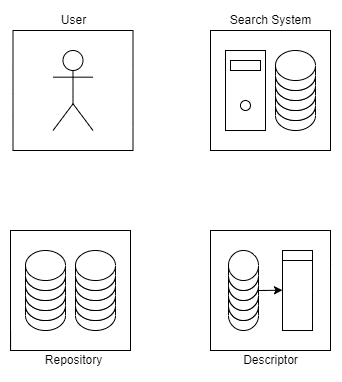
|
|
(animation: 7 frames, duration 6 seconds, no loop limit, 8.77 kb) |
The user interface is the part of the system through which the user will interact with the library. The interface must be multiplatform, i.e. be supported on most modern devices and on any platform. Using the user interface, the end consumer searches for the necessary literature and further interacts with it, viewing it online or downloading it to his device.
The search system is the server part of the system that interacts with the user interface, receiving a search query from it, which must be converted and passed to the descriptor. After receiving a response, the search engine returns the file to the user.
A descriptor is a system that stores data about each library file and creates it when new literature is added. A file has its location in the repository and its metadata. When a request is received from a search engine, the descriptor returns the identifier of the repository where the desired file is stored.
Repository, in other words a storage, that stores all or some part of the library stock of the system. Returns the required file when requested.
2 Architecture of the library system
The architecture of library systems should be considered, like any other architecture of a complex system, at several levels [8].
2.1 Conditional level
he conditional level deals with data, metadata, and meta-object. Data is library materials and metadata is data about an object in a digital library. The traditional record map is an example of metadata for a traditional library. A meta object is an object that provides references to a set of digital objects. In its simplest form, a meta object is a list of other digital objects. For example, a meta object for an anthology is a digital object that lists all the verses. Digital objects are stored to define metadata (data about data). Metadata design is important for literature and information retrieval.
The conditional level representation can be seen in Figure 2.
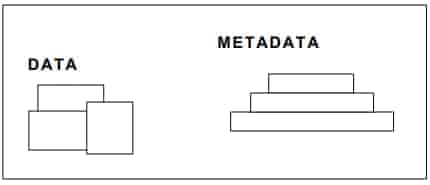
|
|
|
2.2 Operational level
At the operational level of the architecture, it is important how the flow of information through all the components of the system is managed. The digital library will become a set of disparate systems and resources connected through a network and integrated into one interface, most likely a web interface or one of its descendants.
These resources can be on different systems, and in different databases they look like they're on the same system to users. Thus, for both modern and retrospective retrieval, the digital library service must ensure compatibility with the information in the middleware. And this will require some common standards that will facilitate conventional and cross-domain searches. An example of an operational level is shown in Figure 3.
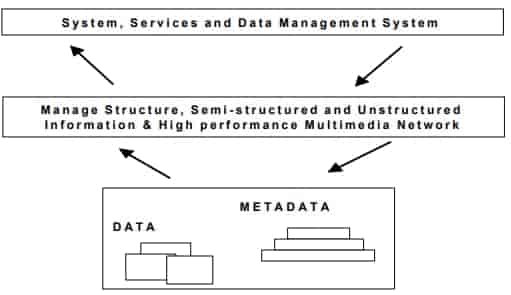
|
|
|
2.3 Technical level
At the technical level, you need to think about the functional component. Metadata is for content and is added to the digital library. It provides information about the content. Thus, metadata and data must be logically linked together, and there must be a reliable underlying technology to manage the logical connection across time, platforms, and over geographic location, in a networked distributed system. This level describes the core functional areas that together provide the necessary components to build robust, scalable and interoperable digital library applications and services with derived digital objects (Figure 4).
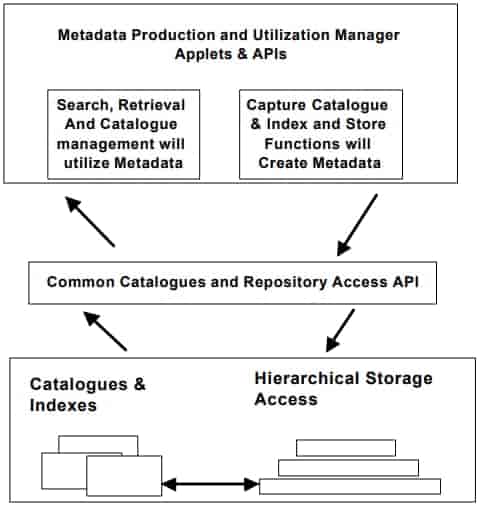
|
|
|
2.4 System level
The system level is streamlined compared to the operational and technical. System feature requirements such as scalability and extensibility can be taken into account at the system architecture level. At this level, the entire electronic library system is represented. We can say that the library system is a centralized subsystem that interacts with a variety of data producers and clients within a complex distributed system (Figure 5).
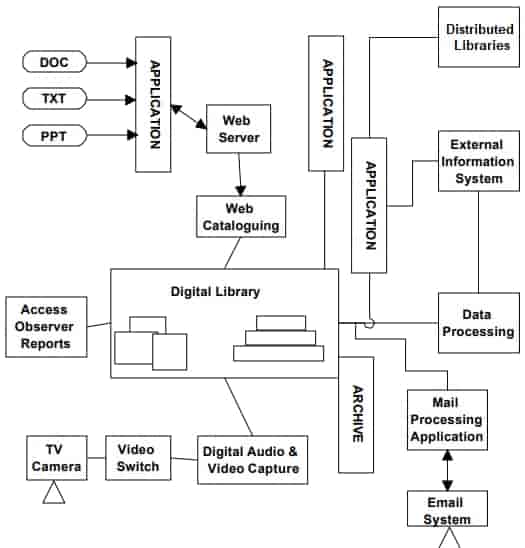
|
|
|
Conclusion
Digital libraries are very important sources of structured, well organized and well stored information [9]. The ideal digital library has a distributed structure, as a distributed architecture promotes modularity, flexibility, and incremental development, and ensures diversity in current and future library environments [10].
Upon completion of the master's work, it is planned to obtain a ready-made library system with a distributed method of storing information. User and administrator will develop their own versions of web applications as interfaces.
References
- DIGITAL LIBRARY | ADVANTAGES & DISADVANTAGES OF DIGITAL LIBRARY | COMPONENTS OF DIGITAL LIBRARY [Ёлектронный ресурс] https://limbd.org/digital-library-advantages-disadvantages-of-digital-library-components-of-digital-library/
- Ёлектронно-библиотечные системы [Ёлектронный ресурс] Ц –ежим доступа: https://samara.mgpu.ru/files/mediacenter/Eylektronno-bibliotechnye_sistemy.pdf
- Ёлектронные библиотеки [Ёлектронный ресурс] Ц –ежим доступа: https://ifap.ru/library/gost/70962016.pdf
- ѕилко ».—., –аспределенные библиотечные системы Ц –ежим доступа: http://www.gpntb.ru/win/ntb/ntb97/10/F10_02.html
- Digital Library System [Ёлектронный ресурс] Ц –ежим доступа: https://www.sciencedirect.com/topics/computer-science/digital-library-system
- DIGITAL LIBRARIES [Ёлектронный ресурс] Ц –ежим доступа: –ежим доступа: https://egyankosh.ac.in/bitstream/103456789/25563/1/Unit-7.pdf
- Richa Pandey, Digital Library Architecture [Ёлектронный ресурс] Ц –ежим доступа: https://core.ac.uk/download/pdf/333967208.pdf
- Hussein Suleman, Design and Architecture of Digital Libraries [Ёлектронный ресурс] Ц –ежим доступа: https://core.ac.uk/download/pdf/232196368.pdf
- Ёлектронна€ библиотечна€ система [Ёлектронный ресурс] Ц –ежим доступа: https://www.sbup.com/wiki/Ёлектронна€_библиотечна€_система
- William Y. Arms, Christophe Blanchi, Edward A. Overly, An Architecture for Information in Digital Libraries [Ёлектронный ресурс] Ц –ежим доступа: https://dlib.org/dlib/february97/cnri/02arms1.html
